
Personnel Excellence, a Rescue Rehearsal and a Fish Strike
Article, Photos and Videos by Todd Miller
June 12, 2016
200 miles offshore, the U.S. Coast Guard rescue helicopter battles heavy rain and 80 knot winds. The pilots try and hold the Jayhawk at a suitable altitude above survivors as they are confronted by 50 – 70’ swells. The crew of the MH-60T is effectively alone in a battle for survival with the elements. Unspoken reassurance is drawn from the HC-130J that circles overhead in the clouds. Somehow in the raging seas they find the boaters in distress, tossed about like mere toys. The sight of the helicopter is as if the arrival of angels, a lifeline appearing in the face of total darkness and desperation. The rescue swimmer and aircraft commander (AC) agree on a plan to reach the desperate survivors. The rescue swimmer secures gear, and with a thumbs up and an encouraging grip on the back from the flight mechanic, drops below the helicopter into the raging torrent. The co-pilot is fully engaged monitoring fuel, engine rpms, and more while the AC holds the MH-60T steady against the winds and outstretched waves.
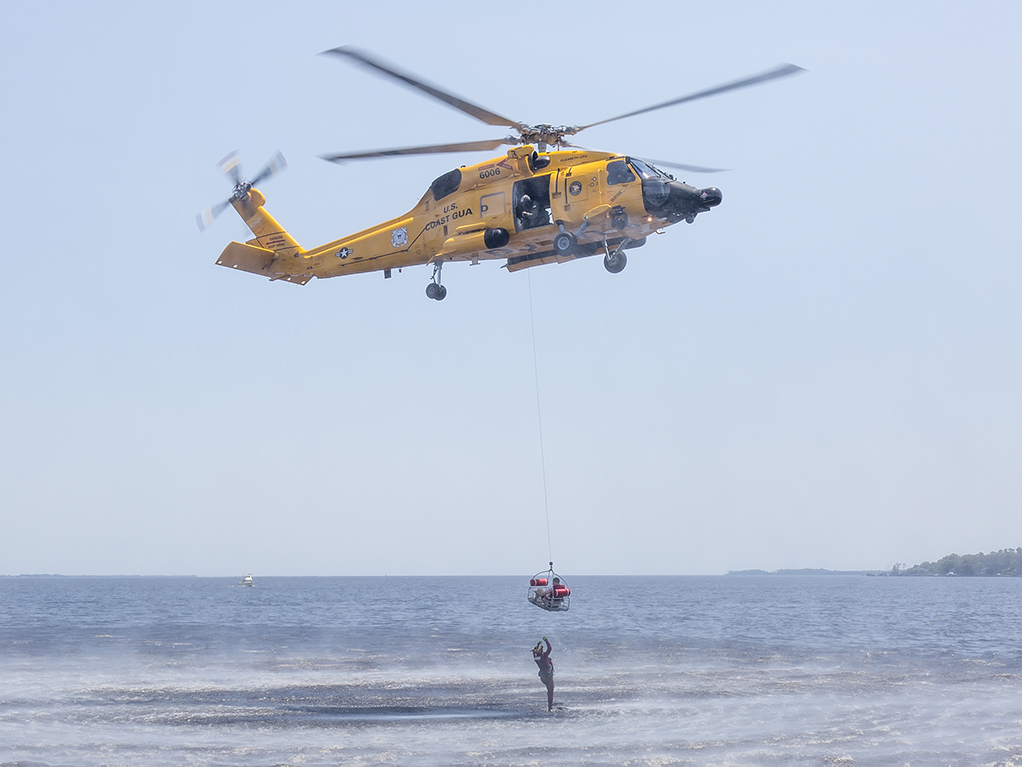
Flight Mechanic Justin Lawrence AMT3 hoists USCG Cadet as Rescue Swimmer (Kyle McCollum AST3) falls away during training exercise at Coast Guard Air Station Elizabeth City, NC (Additional flight crew of MH-60T; Aircraft Commander – CDR Scott Jackson, Co-Pilot – LT Dennis Stenkamp).
Circling above in the clouds the HC-130J functions as a radio relay for the low flying helicopter. Their presence, as distant as it seems, brings reassurance and support to the helicopter crew. If required, the crew of the HC-130J is ready to jump into action low below the clouds to back-up their ‘mates. It is a perilous situation for both crews, particularly for the Coast Guard MH-60T rescue helicopter. Yet it is a situation they race to and embrace. In times like these to call what they do a “job” or a “career” misses the point and verges on disrespect. These crews, that swimmer, are driven by an inner call to be “that man or woman” that brings the distressed seafarer home safely and returns them from the shadow of death to life. “There is nothing like the satisfaction that comes from bringing those in distress safely to shore and witnessing their reunion with desperately thankful family” – Operations Officer, CDR Scott Jackson, U.S. Coast Guard Air Station Elizabeth City.
The entire operation is a testament to man and machine. If the helicopter could talk it would respectfully place the same trust in the Coast Guard aviators that they unwaveringly place in it. The success of the operation is entirely driven by the excellence of the people within the unit: maintainers service the aircraft with little tolerance for less than perfect operation; air crew train to maintain proficiency in all environments; operations and duty personnel drive the organizations activities and rally resources to the mission. A team approach throughout the Coast Guard and the recruitment of the nation’s finest set the stage for excellence.
“What kind of person leaves a perfectly good aircraft?”
Search and Rescue (SAR) may be the highest profile mission of the Coast Guard, yet it is only one of 11 missions they pursue (see inset). The official website of the U.S. Coast Guard notes the Coast Guards effective watch over the “Nation’s maritime interests in the heartland, in the ports, at sea, and around the globe. We protect the maritime economy and the environment, we defend our maritime borders, and we save those in peril.”
The U.S. Coast Guard is the smallest of the 5 military branches in the United States with about 42,000 active duty personnel. Yet their effectiveness and impact is disproportionate to their size. The Coast Guard is a tremendous national asset to ensure uninterrupted commerce on the seas, the safety of professional and recreational boater, environmental protection and more. The U.S. Coast Guard motto Semper Paratus – “Always Ready” applies to all hazards and threats, and has 24/7 implications for rescue operations. By Congressional mandate the Coast Guard has 30 minutes to launch their aircraft once a SAR call is received.
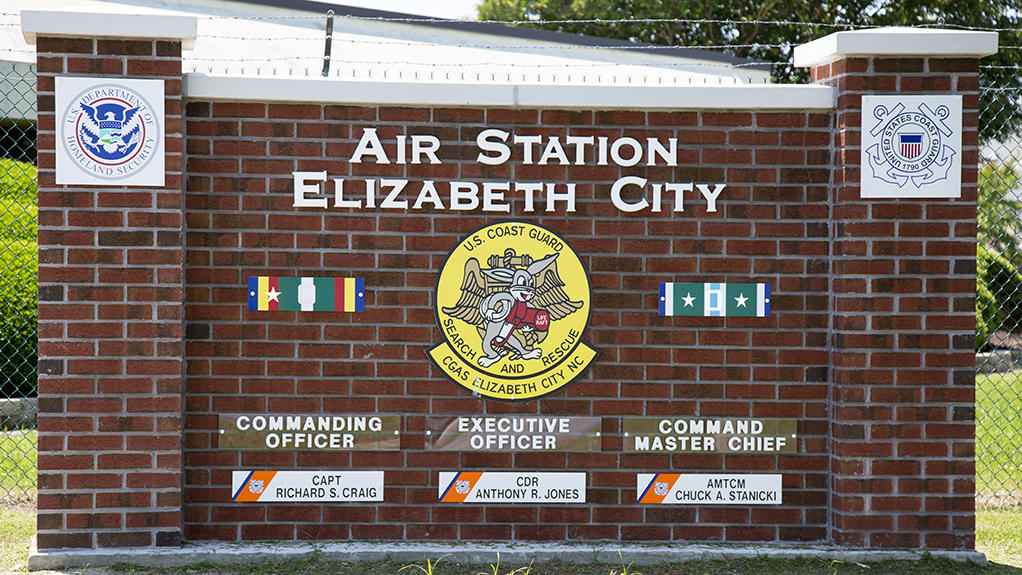
USCG Air Station Elizabeth City
The Coast Guard Base located at Elizabeth City, NC is home to a number of significant Coast Guard Centers and Departments, including Air Station (AirSta) Elizabeth City under the command of Captain Richard “Scott” Craig. Air Station Elizabeth City participates in six of the eleven Coast Guard missions. Being the primary Air Station on the East Coast, Elizabeth City is responsible for a massive area, with HC-130Js traveling beyond Iceland, to the Azores and throughout the Caribbean. The MH-60Ts are a regional (Mid-Atlantic) asset covering the local area. There are a number of Air Stations up and down the East coast with helicopter assets serving their local areas.
According to the Operations Officer, CDR Scott Jackson the Air Station has about 340 personnel, 44 of whom are pilots. The Air station flies and maintains 5 Lockheed HC-130Js and 4 Sikorsky MH-60Ts. The HC-130Js are new aircraft incoming to the Coast Guard Fleet and are currently based only at Air Station Elizabeth City. Air Stations in HI, AK, CA & FL fly the legacy HC-130H, though the Coast Guard plans to replace those with “J” models by 2027 based at Air Stations in HI, CA, AK & NC.
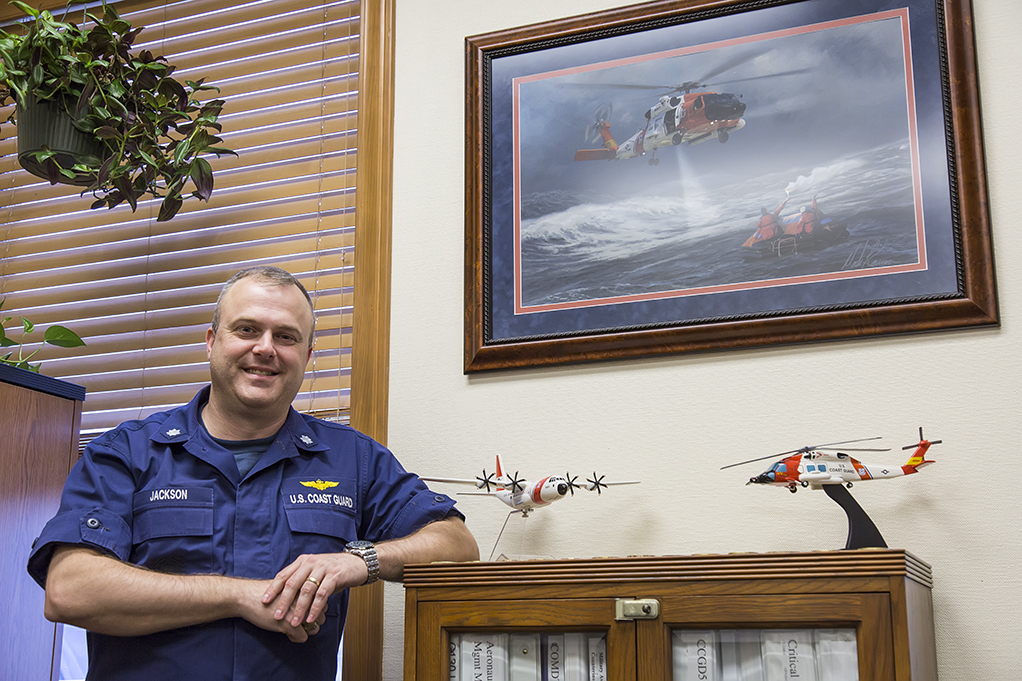
CDR Scott Jackson, Operations Officer and Chief Pilot, United States Coast Guard – Air Station Elizabeth City, NC
The wide area covered provides additional challenges and interest for the HC-130J crews. Compared to the “H” model, the “J” offers increased speed, range, inverse synthetic aperture radar (ISAR), forward looking infrared/electro optical sensor (FLIR/EOS), advanced communications gear and improved oxygen system. Given the distances flown a challenge more unique to the HC-130J (vs. MH-60T) is weather. Crews must carefully consider the conditions along the entire route and plan accordingly. As a general rule the HC-130J is used on SAR missions as a rapid response unit (over longer ranges), and often remains on site at higher altitudes ensuring a communications link for the low flying helicopters. HC-130J pilot LT Zac Bowers notes that pilots always have to maintain an edge, because in spite of the best preparation conditions can be challenging. Storms buffet the aircraft and turbulence may cause altitude to bounce up and down hundreds of feet. When trying to effect a rescue below a low cloud ceiling it is imperative to maintain a minimum altitude hundreds of feet higher than the maximum effect of the turbulence.

HC-130J of USCG Air Station Elizabeth City returns to base after night flight.
These crews often find themselves in rough weather – a total contrast to the flight I participated in (A SAR Exercise or SAREX) that took place with blue skies, calm seas and smooth air. Case in point was the rescue of the crew of the HMS Bounty during hurricane Sandy. The HC-130J maintained a presence on site dropping rafts and marker buoys, fighting horrible weather to sustain those on the water until the helicopters could arrive on scene. The story (link above) is a great read describing the conditions faced by crews on both the HC-130J and the MH-60Ts involved. On difficult searches the HC-130J will often fly with the rear ramp down for improved scanning of the water by the crew. Hours on the ramp in inclement weather is simply “part of the job.”
Beyond search and rescue, the HC-130J crew is involved in a variety of critical and interesting missions. Deployed on drug interdiction missions in the Gulf the crews utilize their ISAR and FLIR/EOS for indication of fast boats and then move in for the intercept. Cooperating with a joint task force, homeland security, and even supporting U.S. Navy or U.S. Air Force exercises may all be part of a day’s work. Bowers finds the variety fantastic and relishes the exposure to so many enriching experiences such as: taking off in the morning and flying to the Bahamas and back; heading out to a small island and landing on a short, narrow and unimproved runway; or flying out of St Johns, Newfoundland and doing ice patrols along the coast of Greenland. The life of an HC-130J pilot in the Coast Guard is clearly fulfilling.
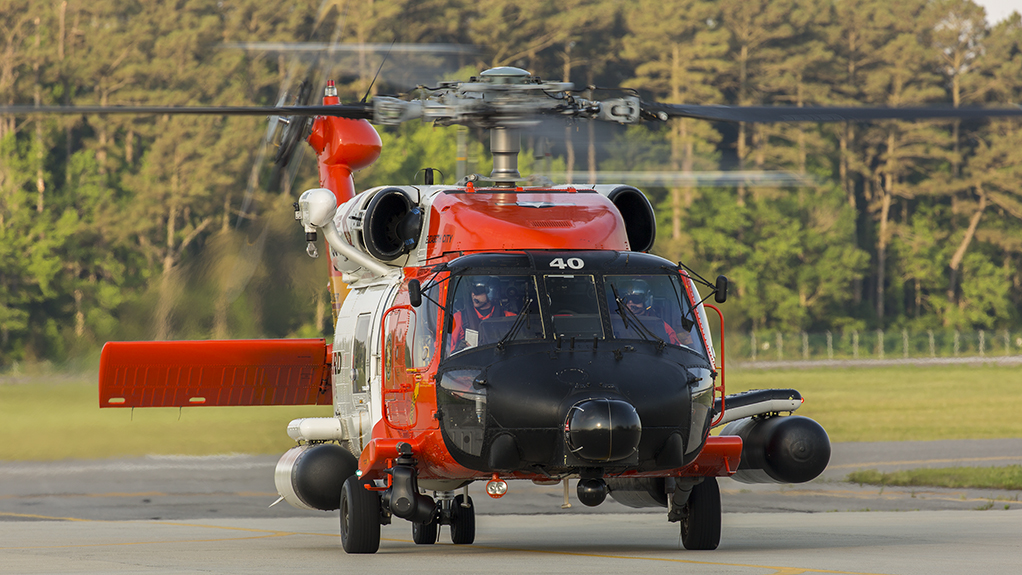
USCG Sikorsky MH-60T taxis to ramp after landing at Air Station Elizabeth City, NC
Jackson, an MH-60T pilot himself, has the primary role directing operations. He notes that the MH-60T pilot has a different experience than those of the HC-130J. Much more focused on a regional area (the natural result of the helicopters reduced speed and range) the MH-60T is also by role much closer to the “action.” As in the HMS Bounty rescue, the helicopter pilots utilized night vision goggles (NVGs) to fly a few hundred feet above the water in torrential rains and strong winds. Once moving into recovery, the helicopter battled the elements, including swells which seem to reach up and attempt to snatch the chopper out of the air. All this while rescuing survivors.
Aside from those rescued, I doubt the average American appreciates how extraordinary it is to have professionals and machines that can deal with these conditions to save seafarers from certain death. It is not by accident. The HC-130Js and MH-60Ts have complex systems and are utilized in adverse conditions. Jackson must ensure pilots and aircraft are “Always Ready” and to that end, the maintenance and flight crew proficiency cycles take place around the clock. To the casual visitor, the process appears seamless and fluid. A helicopter is down for an avionics issue and in hours it is repaired, tested (ground run if required) and back in service. One HC-130J is pushed out of the hangar and another one is pulled in and in a matter of hours may have props removed, and extensive maintenance underway.
The capabilities to address avionic, electronic, power plant, hydraulic and airframe issues at the Air Station level is impressive. In the rotary hangar an MH-60T was receiving a new gearbox and was extensively “torn” down. Within a few days it was solidly coming back together, one piece at a time, methodically and persistently. Such work is a credit to the quality and capability of the entire team of maintainers and their leadership.
| Enlisted Aviation Positions | Associated Flight Role |
|---|---|
| Aviation Maintenance Technician (AMT) | Flight Mechanic |
| Avionics Electrical Technician (AET) | Flight Mechanic |
| Aviation Survival Technician (AST) | Rescue Swimmer |
This speaks to a uniqueness that sets the U.S. Coast Guard apart from the other military branches. Most Coast Guard personnel in the aviation community are “multi-role” by design. Once AMTs, AETs and ASTs receive their technical training for their field of expertise, they may also qualify/train to become part of aircrew. This multi-role aspect contributes to a unique team environment.
Flight Mechanics who maintain the Avionics, Electronics and Airframe of the aircraft are also flying with the flight crews. The pilots also participate in multiple roles, handling operational responsibilities and duty station along with flying. They all engage intimately as a team, communicating and performing missions in seamless fashion. As AET3 Justin Kotraba expressed, aside from a broad workload, the end result is high morale and a real sense of being part of the mission and the team. It is a very positive organizational structure.
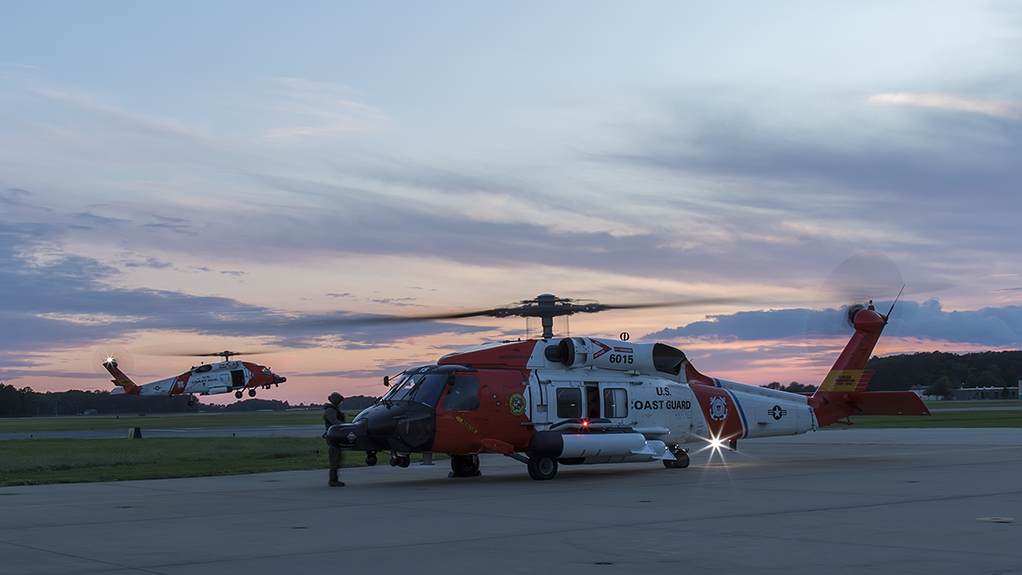
Pair of USCG MH-60Ts departing at sunset for night training missions.
Never far from any role is that of purpose. Each group (AMT, AET, & AST) have their own shops at the Air Station and in those shops hang life preservers of those rescued by AirSta Elizabeth City crews over many years. A visit to the room in the non-descript swim shop is like visiting a shrine. Stand quietly and reflect on the scores of life preservers that represent real lives saved. Behind each preserver a story worth telling over and over: 24 people loaded on one helicopter; during hurricane Sandy the rescue of the HMS Bounty crew; a rescue swimmer holding a baby overhead while swimming in rough seas to the rescue basket; a rescue swimmer folded over so badly by a massive wave their back was badly and permanently damaged.
The AST/Rescue Swimmer is trained and must be capable to handle the worst. The training “curriculum” is rightfully challenging given a recent class of 24 graduated 4. By design the course is physically and mentally demanding. Pause and attempt to internalize. 220 miles offshore in a MH-60T, 80 mph winds, 40 foot swells, blinding spray and temperatures hovering just above freezing. The swimmer descends into the frothing seas and fights against the overpowering force of the ocean to make their way to those in need of rescue. The swimmer gets the survivor into a rescue basket and then waits to be the last back on board. As many have said, “What kind of person leaves a perfectly good aircraft?”
A lengthy conversation with AST3 John Fuller (in the process of qualifying to become a swimmer) provides a glimpse inside a swimmer. The swimmer lives for the moment of being tossed into the crucible. Part personal test, and part a desire to be that man or woman that answers the call. If you don’t have it, I doubt you can understand it. No words can evoke the significance of what the entire Coast Guard flight crew accomplishes in this mission. Purpose driven living, purpose driven job satisfaction.
Personnel have very specific requirements they must meet to ensure proficiency. Hours of flight, flight with night vision googles, hoists, auto rotations, air drops, touch and goes etc. It is primarily the responsibility of each member to ensure they are scheduled to meet and exceed the required minimums to maintain proficiency. Utilizing and maintaining excellent equipment, and keeping personal proficiency high ensures the Coast Guard is as safe a place to work as possible. As much as the flight crews put their lives “on the line” – everything is done to mitigate the risk and ensure that all come home safely.
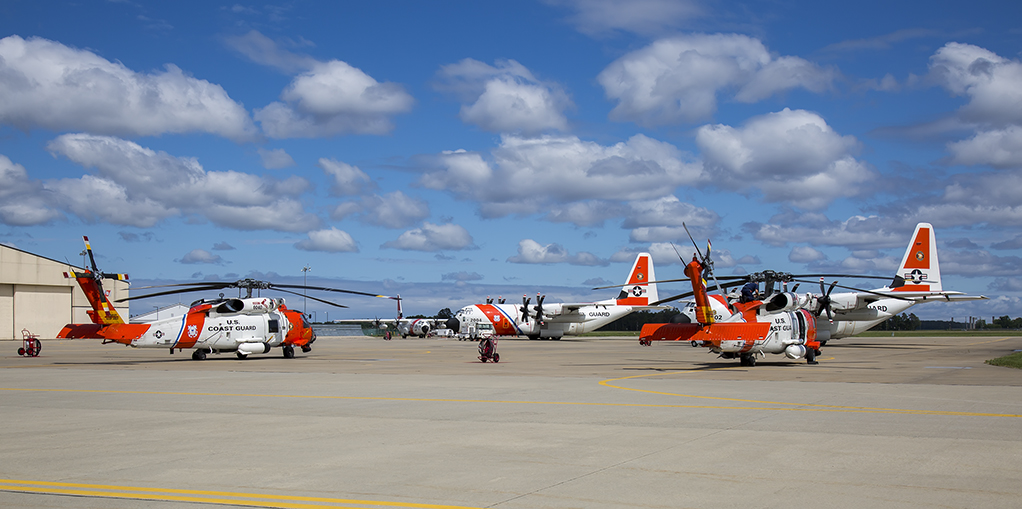
Ramp Area with a number of USCG rescue assets – Elizabeth City, NC
Jackson takes the safety of his crews personally, and finds himself losing sleep when Elizabeth City crews are deployed on a difficult rescue. He has the authority to reject responding to a mission if he deems there are any circumstances that make the mission risks unacceptable. In the same way, the aircraft commander (AC) can refuse to deploy the swimmer, or the swimmer can refuse to deploy to a situation where the risk is deemed unacceptable. Both AC and Swimmer must agree on deployment before the swimmer is deployed.
Participating in a training mission in the HC-130J provided the opportunity to be a part of some history – and a Coast Guard “fish story.”
Like any of the military services, careful plans are made for each training operation with associated crew briefings. However, the nature of the Coast Guard is such that flexibility and initiative is part of the mission. Once a crew is dispatched on a mission, there is an ongoing “briefing” led by the AC to adjust plans as more information is received and what may have been a murky situation becomes clear. Search patterns may be adjusted given a sighting, or weather conditions. Plans to retrieve people in distress require flexibility given the nature of “rescue.”
It was a pleasure experiencing firsthand the clear communication and team coordination of both the HC-130J crew on a search and rescue exercise (SAREX) and the MH-60T in a rescue situation. A number of U.S. Coast Guard Academy cadets were on base as part of their summer internship, and I observed their “rescue” from the waters adjacent the Air Station. A boat and crew was provided by a member of the Coast Guard Auxiliary. It was meaningful to see these experienced sailors supporting the Coast Guard, as well as the way the Coast Guard embraces their participation.
Within a few moments the MH-60T with the bright yellow paint scheme commemorating the Centennial Year of Coast Guard Aviation 1916-2016 arrived alongside. Once a number of the cadets had been hoisted I moved from the boat to the helicopter for the birds-eye (flight mechanics) view of the procedure. The aircraft commander, flight mechanic and rescue swimmer communicated precisely and clearly. No one was left wondering what the other person was thinking. The procedures followed were clear with the rescue approach briefed before the swimmer left the helicopter. All contingencies were accounted and planned for “Hover at 40, if we lose an engine we are going left of the boat” etc. Once in the hoist position the flight mechanic (hoist operator) becomes the pilot’s eyes – “forward 20, forward 10, in the basket, basket coming up.”

USCG Cadet getting in the basket of the MH-60T Air Station Elizabeth City, NC
The MH-60T was exceptionally stable as the 6 cadets were hoisted up and down, and the crew made this look as easy as loading motivated teens in a minivan. Granted, conditions were perfect with clear skies, no wind, and calm water. One has to continually keep in mind that the crew must complete similar operations in incredibly adverse conditions. The rescue swimmer certainly met and exceeded his minimums for the day, spending the better part of 90 minutes in the water battling rotor wash and moving the 11 cadets in and out of the rescue basket.
The Coast Guard (like any of the branches) is always looking to build the team with great candidates. For young people the Coast Guard Academy is one approach, and another is the “College Student Pre-Commissioning Initiative” (CSPI) similar to the Reserve Officers Training Corps (ROTC) program offered by other military branches. The CSPI is a great way to get started on a Coast Guard career. Regardless of path, the process generally involves “getting in” and taking an initial “tour” of a couple of years, and then moving into a desired career path. The Coast Guard is very good at providing opportunities to migrate to your desired position once in the service. Bowers himself served in a law enforcement role on a Coast Guard Cutter for a two-year tour following Officer Candidate School (OCS), and then migrated to his desired role of HC-130J pilot.
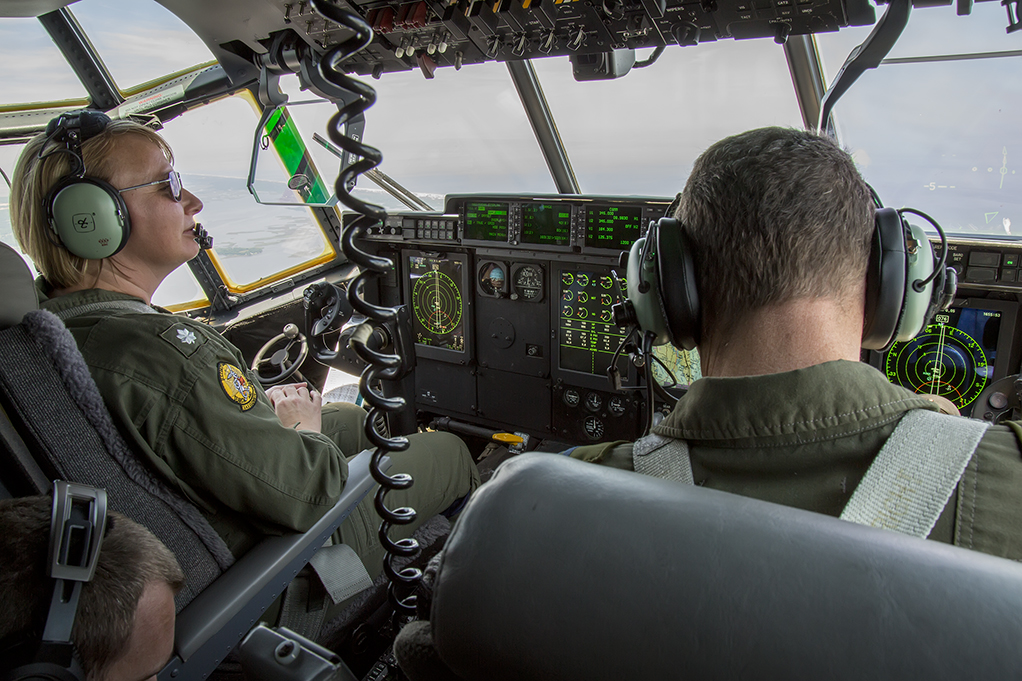
HC-130J (CGAS Elizabeth City, NC) crew in flight for SAREX off the coast of NC/Virginia; Aircraft Commander Maj Rob Jones (RCAF Exchange Pilot), Co-Pilot CDR Rachel Eldridge, Loadmaster Chris Obrien.
Participating in a training mission in the HC-130J provided the opportunity to be a part of some history – and a Coast Guard “fish story.” Sitting in the back of any military transport provides little situational awareness and the HC-130J is no different. Following a pre-flight safety brief that I certainly hoped would not be relevant, I settled in sitting sideways along the cargo bay. The engines roared to life for the take-off run. We bobbed down the runway and I could feel the HC-130J getting lighter on the wheels, nearing rotation. Suddenly, the aircraft lurched as the brakes were applied and the engines kicked into reverse thrust for braking. The HC-130J oscillated under the reverse thrust and we came to an abrupt stop. Unable to see and not connected to comms I surmised the abort was caused by a runway or flightpath incursion by another aircraft, or perhaps a flock of birds?
As the aircraft began to taxi back to the ramp, I would learn that I may have been part of Coast Guard history. The take-off had been aborted due to a fish strike! Flying fish in NC? Apparently an Osprey had settled on the runway to enjoy the catch of the day. Leaving with the catch likely slowed the bird enough to result in his untimely and unfortunate end, as well as a heavy “flying fish” strike on the nose of the fuel tank on our left wing. A rescue mission may well have continued, but the training mission was scrubbed. That night the HC-130J was pulled into the hangar for further inspection and to repair the nose cone of the fuel tank. While off the flight line the opportunity was taken to perform additional maintenance and within a short period of time props had been removed and all kinds of work was underway.
The Coast Guard is the sum of individual members living lives with purpose.
The SAREX was rescheduled, and after a day passed we departed without incident. The exercise itself was plausible enough. Given our proximity to Virginia Beach and Naval Air Station (NAS) Oceana (the base for the U.S. Navy’s Atlantic Fleet of Strike Fighters) we would be simulating a search for downed F/A-18 pilots off the coast. Coordinating with the Navy and other agencies the Coast Guard HC-130J would be assuming command and control of the search from a Navy E-2 Hawkeye. A Coast Guard helicopter, cutter, and a number of U.S. Navy SH-60s would be involved in the search. Three life preservers/rings (representing the F/A-18 flight crews) would be dropped in the water, and it would be our role to work a grid and coordinate activities to find and retrieve the preservers/rings.
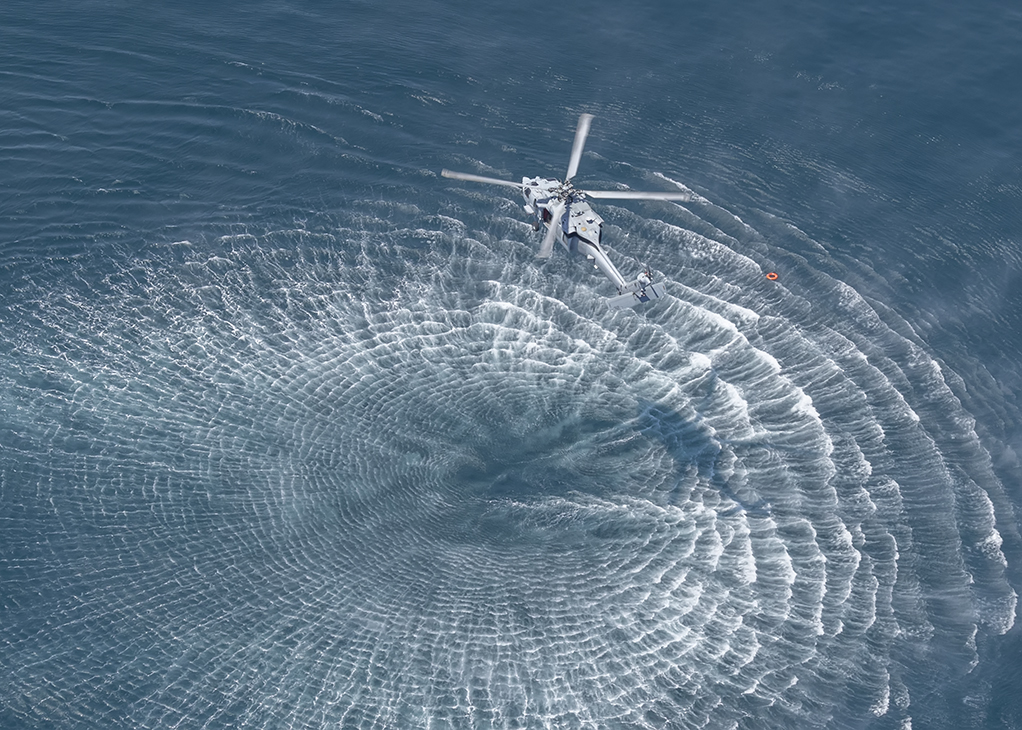
Navy SH-60 closes in on life ring representing a downed pilot during SAREX exercise; May 25; 2016;
The weather was perfect, with calm seas and pristine skies. The HC-130J AC Major Rob Jones was a Royal Canadian Air Force (RCAF) exchange pilot serving a 3 year term with the U.S. Coast Guard. The opportunity to train and serve with allies within the U.S. and have U.S. pilots serve with them creates a richer experience for all involved. After a short flight to the search area, the HC-130J set up at 3500 ft. to work the grid and coordinate activates below. After some time in orbit the aircraft dropped to 1000 ft. and we circled over the U.S. Coast Guard Cutter Cochito and Navy SH-60s as they searched the waters.
The ocean is endless, and the cliché “searching for a needle in haystack” seems inadequate to describe what it is like to search for a person in perfect conditions let alone in rough water. Yet, if required the Coast Guard will spend hours flying the grid in poor weather all eyes contributing to the search. In many cases the advanced search radar and systems on the HC-130Js will be of tremendous assistance. In our case, the ideal conditions facilitated spotting and retrieving the preservers/rings. We returned to Air Station Elizabeth City after about 3.5 hours in the air.
Just another training operation to build hours and give Coast Guard and Navy personnel something to do? The following day, two Navy F/A-18Fs collided off the coast, and all 4 crew members ejected and parachuted into the ocean. Air Station Elizabeth City scrambled 3 MH-60Ts and one HC-130J to effect the rescue of the F/A-18F crews. Train one day, rescue the next. Always Ready – much more than a motto, a reality!
The reality of my experience leaves me pondering ironies. A job or a calling? Fulfilling responsibilities, just doing your job – or putting your own life in peril, a hero? Perhaps it is perspective. Ask the members and they’ll talk about doing their job and how much they love it. Ask a seafarer rescued from a raging storm and the entire Coast Guard crew are heroes (I would feel the same way!).
Unlike many professions, members of the Coast Guard may measure their lives tangibly by the successful completion of missions: drug interdiction; coastal security; environmental protection; and lives saved. So many missions, so much value. I can only conclude that the Coast Guard is the sum of individual members living life with a purpose.
Thank-you to the personnel at USCG Air Station Elizabeth City. I interacted with so many personnel all of whom were incredibly accommodating and gracious. Specific gratitude to PAO and MH-60 pilot LT Chris Pulliam, HC-130J pilot LT Zac Bowers, AET3 Justin Kotraba, AST3 John Fuller, the HC-130J crew of AC Maj. Rob Jones (RCAF Exchange Pilot), Co-Pilot CDR Rachel Eldridge, Loadmaster AMT2 Chris Obrien, and the MH-60T crew of AC CDR Scott Jackson, Co-Pilot LT Dennis Stenkamp, Flight Mechanic AMT3 Justin Lawrence and Rescue Swimmer AST3 Kyle McCollum.
Click on an image below to page through the gallery:
Todd Miller resides in rural Maryland west of Baltimore. Given less than required eyesight Todd’s dreams of fighter pilot were grounded, but the love of military aviation has never subsided. Todd enjoys capturing military aircraft through photography, with a particular desire to capture them in mission action. When not busy chasing jets, Todd works in the area of Business Development for a prominent flooring materials company.
Todd can be reached at: [email protected]


